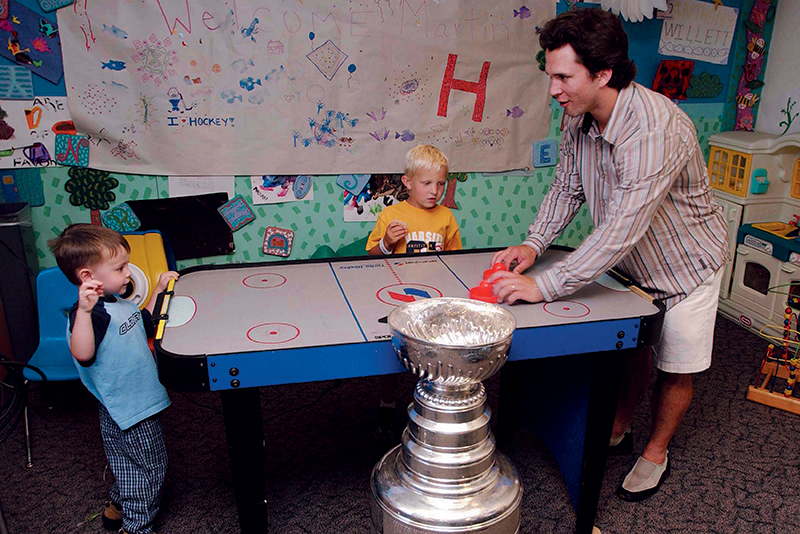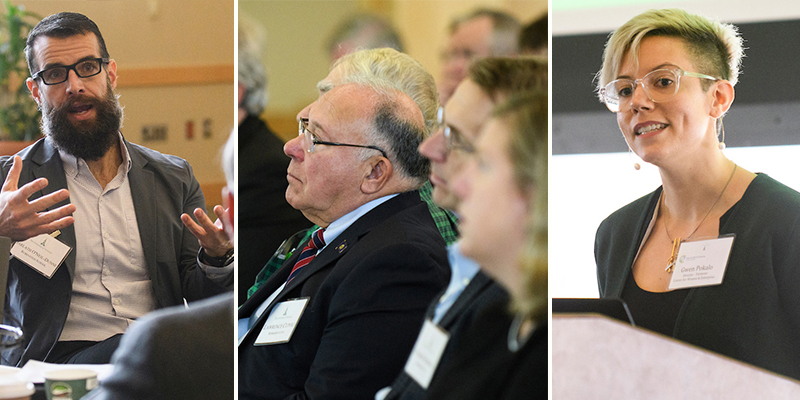As Catamount hockey great Martin St. Louis ’97 is inducted into the NHL Hall of Fame, we take a look back at the pinnacle of his career, the 2003-04 season, with an article from the archives of Vermont Quarterly.
Just for fun, let’s count the ways a screenwriter could pitch a Hollywood studio with a movie concept called something like “Une Bell Saison: The Martin St. Louis Story.”
He’s the against-all-odds little guy in a big guy’s game. The discarded pro who battles for a championship against the organization that cut him loose. The old teammate reunited with his longtime pal in the final weeks of a dream season. The injured athlete who takes a badly broken leg as a challenge to build himself stronger. Wait, there’s more. The loyal friend who, in the midst of a playoff run, dedicates his games to a childhood buddy who just died of cancer. The player overlooked in the NHL draft who, seven years later, takes the league’s most valuable player awards.
Too much?
Combined, the elements of Martin St. Louis’s 2003-2004 season could rival “Miracle” as a paean to over-achievers on two blades. But just as the tale of the 1980 U.S. Olympic hockey team didn’t require much Disneyfication, so the St. Louis story stands on its own.
If there’s one place where the various plotlines intersect and capture both character and story, it’s in the Tampa Bay Lightning’s clubhouse last December. Coach John Tortorella was concerned that the team was beginning to backslide after stepping up in the previous season to win a round in the playoffs, significant progress for a long-somnolent franchise. Tortorella called together several of his top players at key moments, the sort of efforts that often spell the difference between a win and a loss.
St. Louis was among the handful on the receiving end of Tortorella’s talk, something between a chewing out and tough love. Ten minutes later, St. Louis was the first to knock on the coach’s door to accept the challenge. He told Tortorella, in essence, “Give me the puck.” St. Louis asked the coach to put him in the game during power plays, the last minute of periods, on offensive zone face-offs. “Game breaking times,” he said.
Long impressed by St. Louis’s mental toughness, Tortorella took his player up on the offer. That was arguably the move that made the Lightning and St. Louis’s season take off and not return to Earth until Tampa Bay took the Stanley Cup and their fast-rising star notched two most valuable player nods, one from sportswriters and one from his fellow players in the NHL.
Wayne’s World
There’s no trophy case in the South Burlington duplex where Martin and Heather St. Louis and their toddler son, Ryan, live during the off-season. So, the 2004 Lester B. Pearson Trophy, which goes to the National Hockey League’s outstanding player as voted by his peers, has a spot on the dining room table along with the last few days’ mail, Marty’s tin of Skoal, and Ryan’s little plastic tub of Cheerios and sippy cup.
The two-foot-tall prize of bronze and lacquered wood looks a bit out of place amidst the stuff of family life. St. Louis would be the first to admit that seeing his name engraved next to the likes of Phil Esposito, Guy LaFleur, and Mario Lemeiux takes some getting used to, as well. He points to one panel of names and says, “Gretzky owns this one.” ’82, ’83, ’84, ’85, ’87.
It’s not the first time St. Louis and Canada’s greatest hockey hero have shared space this season. St. Louis earned back-to-back NHL Player of the Month awards this year, the first since Wayne Gretzky to earn the honor in consecutive months. When a reporter asked him what it was like being mentioned together with “The Great One,” St. Louis said, “It’s a little weird, to be honest.”
There’s been a fair amount of weirdness to get used to in St. Louis’s life lately, albeit weirdness of the wouldn’t trade it for the world, lifetime dream sort. July 29 marked a prime case in point. The Stanley Cup traditionally travels the world in the summer after the championship, spending a day with each member of the winning team. The many-tiered silver grail arrived at Burlington International Airport early in the morning and soon re-joined St. Louis at the Sheraton, where thousands of fans lined up to get their photos taken with St. Louis and the cup. (The event doubled as a fundraiser, netting $7,500 for a local charity.) Then St. Louis and the Stanley Cup moved on to Gutterson for a small reception, a trip around the pediatrics ward at Fletcher Allen (pictured below), a run up Church Street, and finally a private party where The Samples were house band for the night, joined on-stage for a few songs by three members of Phish.
UVM to MVP
The St. Louis family is enjoying a welcome breather at home in early August, a brief window between post-championship/MVP hubbub and Martin’s departure to play for Team Canada in the World Cup, not to mention a second round with the Stanley Cup in hometown Laval, Quebec. While Heather plays with Ryan in the next room, Martin sinks into the couch, puts his feet up on the coffee table, and reflects on the startling rise of his hockey career.
Unlike many college athletes with pro potential, St. Louis was in no hurry to leave school early. After his junior season, the year the Catamounts went to the NCAA’s Frozen Four, he had an offer from the Washington Capitals to turn pro but turned it down in favor of one more year of college hockey and finishing up his degree in small business management.
A sound plan and a mature one, but the only problem was that an NHL offer wasn’t there after St. Louis’s senior year. He held steadfast to the plan. “I knew that somehow I was going to play hockey — Europe or in the NHL. I was going to chase the dream for a little bit.” He signed with Cleveland of the International Hockey League, eventually moving on to the NHL with Calgary.
Heather Caragol St. Louis ’97, an accounting major from Connecticut who met her future husband over the summer between their junior and senior years, says she never saw his confidence falter as he climbed through the professional hockey ranks. “When he went from Cleveland to the Calgary organization, he took a pay cut. But he was willing to do that in hopes it would increase his chances,” she says. “He just knew that if he was presented with an opportunity, he could make it.”
After the disappointment of being put on waivers by Calgary in 2000, and passed over by every team in the league, St. Louis landed with Tampa Bay. The team would prove to be the opportunity and good fit he’d long sought, and St. Louis began to emerge as a top player and scoring leader with the Lightning. But nearly as soon as he’d met one challenge, St. Louis was faced with another when he suffered a bad break to his leg in March 2002.
“People told me that I wouldn’t have the same balance, I wouldn’t have the same strength,” St. Louis says. “I felt like I had something to prove to myself and other people — I’m not going to let this injury ruin my career.”
Over the summer, as St. Louis worked out in UVM’s weight-room and ran countless steps in Gutterson, he lifted his trademark tenacity to new levels and built his tree-trunk legs to near special effects proportions. He shows off the surgical scar where a plate and six screws mended his fibula, says the leg is stronger than ever, but knocks on the coffee table for good measure. “I’m stubborn in many ways,” St. Louis says. “When people tell me that I can’t do things, I’ve got that drive to prove people wrong, that I’ll-do-it-better-than-you kind of thing.”

‘Who is this guy?’
Any conversation with Martin St. Louis about his hockey career, one suspects, is going to cycle back around to hard work. He’s firm in his belief that it has a lot more to do with his success than talent and begins the credit with his parents. “My dad has been a hard worker his whole life. He’s from a family of 14 kids, started working when he was eight years old,” St. Louis says. “He knows what work is. Sometimes people think they’re working hard, but compared to what?”
Nowhere are St. Louis’s work habits on more vivid, or public, display than in a hotel fitness center. Heather St. Louis mentions a recent trip and says it’s a tough place for her husband to hide his rising celebrity status. She smiles as she alludes to his routine of weights, running, and plyometrics and says, “If you or I were in a gym seeing him do the things that he does, we’d think that he was nuts. People think, ‘Who is this guy? Because nobody works out like that unless he’s being paid to do it.’’’
The regimen of drills of a hockey player in training are a good deal more familiar to St. Louis’s usual summer workout partners at Gutterson, which include a number of UVM hockey players past and present. Familiar, but there’s much to be learned from his intensity. St. Louis says if there is one thing he can pass on to Coach Kevin Sneddon’s current players as they seek to return UVM to the heights of the St.Louis-Perrin-Thomas era, it’s that they just see how hard he works.
“I don’t care how good you are, you still have to work hard to get to the next level. There are a lot of great players who don’t make it,” he says. “There are tons, and it is the work ethic that makes the difference. Some just think it is going to happen because they are gifted.”
Even now, even Martin St. Louis doesn’t seem to have quite accepted that it has really happened. Tampa Bay coaches say he has an old habit, dying hard, of checking the roster posted in the locker room to be sure he’s still on the team. In pro sports’ culture of entitlement, that’s a rare attitude, one that has earned him the respect of fans and the front office, players and the press. To St. Louis, it’s simply the thread of a straight-forward, well-worn plotline that has worked from Quebec to Vermont to Florida and shows no signs of taking a twist.
“You can’t take it for granted. You take things for granted, you relax, you let go, you don’t push as hard,” he says. “You forget what it took to get here.”
Photos by Bill DiLillo, Sally McCay, and Adam Riesner.
Source: UVM News



